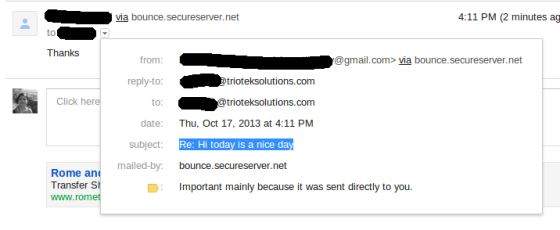JavaMail API - 回复电子邮件
在本章中,我们将了解如何使用 JavaMail API 回复电子邮件。以下程序中遵循的基本步骤如下:
获取属性中包含 POP 和 SMPT 服务器详细信息的 Session 对象。我们需要 POP 详细信息来检索消息,需要 SMPT 详细信息来发送消息。
创建 POP3 存储对象并连接到存储。
创建文件夹对象并打开邮箱中的相应文件夹。
检索消息。
遍历消息并输入"Y"或"y"(如果要回复)。
获取消息的所有信息(收件人、发件人、主题、内容)。
使用 Message.reply() 方法构建回复消息。此方法使用适当的收件人和主题配置新消息。该方法采用布尔参数,指示是仅回复发件人(false)还是回复所有人(true)。
在邮件中设置发件人、文本和回复,并通过 Transport 对象的实例发送。
分别关闭 Transport、文件夹和存储对象。
这里我们使用了 JangoSMPT 服务器,通过该服务器将电子邮件发送到我们的目标电子邮件地址。设置在环境设置一章中有说明。
创建 Java 类
创建一个 Java 类文件 ReplyToEmail,其内容如下:
package com.tutorialspoint;
import java.io.BufferedReader;
import java.io.InputStreamReader;
import java.util.Date;
import java.util.Properties;
import javax.mail.Folder;
import javax.mail.Message;
import javax.mail.Session;
import javax.mail.Store;
import javax.mail.Transport;
import javax.mail.internet.InternetAddress;
import javax.mail.internet.MimeMessage;
public class ReplyToEmail {
public static void main(String args[])
{
Date date = null;
Properties properties = new Properties();
properties.put("mail.store.protocol", "pop3");
properties.put("mail.pop3s.host", "pop.gmail.com");
properties.put("mail.pop3s.port", "995");
properties.put("mail.pop3.starttls.enable", "true");
properties.put("mail.smtp.auth", "true");
properties.put("mail.smtp.starttls.enable", "true");
properties.put("mail.smtp.host", "relay.jangosmtp.net");
properties.put("mail.smtp.port", "25");
Session session = Session.getDefaultInstance(properties);
// session.setDebug(true);
try
{
// 获取 Store 对象并连接到当前主机
Store store = session.getStore("pop3s");
store.connect("pop.gmail.com", "xyz@gmail.com",
"*****");//相应地更改用户和密码
Folder folder = store.getFolder("inbox");
if (!folder.exists()) {
System.out.println("inbox not found");
System.exit(0);
}
folder.open(Folder.READ_ONLY);
BufferedReader reader = new BufferedReader(new InputStreamReader(
System.in));
Message[] messages = folder.getMessages();
if (messages.length != 0) {
for (int i = 0, n = messages.length; i < n; i++) {
Message message = messages[i];
date = message.getSentDate();
// 从消息中获取所有信息
String from = InternetAddress.toString(message.getFrom());
if (from != null) {
System.out.println("From: " + from);
}
String replyTo = InternetAddress.toString(message
.getReplyTo());
if (replyTo != null) {
System.out.println("Reply-to: " + replyTo);
}
String to = InternetAddress.toString(message
.getRecipients(Message.RecipientType.TO));
if (to != null) {
System.out.println("To: " + to);
}
String subject = message.getSubject();
if (subject != null) {
System.out.println("Subject: " + subject);
}
Date sent = message.getSentDate();
if (sent != null) {
System.out.println("Sent: " + sent);
}
System.out.print("Do you want to reply [y/n] : ");
String ans = reader.readLine();
if ("Y".equals(ans) || "y".equals(ans)) {
Message replyMessage = new MimeMessage(session);
replyMessage = (MimeMessage) message.reply(false);
replyMessage.setFrom(new InternetAddress(to));
replyMessage.setText("Thanks");
replyMessage.setReplyTo(message.getReplyTo());
// 通过验证 SMTP 服务器来发送消息
// 创建一个 Transport 实例并调用 sendMessage
Transport t = session.getTransport("smtp");
try {
//使用传输实例连接到 smtp 服务器
//相应地更改用户和密码
t.connect("abc", "****");
t.sendMessage(replyMessage,
replyMessage.getAllRecipients());
} finally {
t.close();
}
System.out.println("message replied successfully ....");
// 关闭存储和文件夹对象
folder.close(false);
store.close();
} else if ("n".equals(ans)) {
break;
}
}//end of for loop
} else {
System.out.println("There is no msg....");
}
} catch (Exception e) {
e.printStackTrace();
}
}
}
您可以通过取消注释语句 session.setDebug(true);来启用调试
编译并运行
现在我们的类已准备就绪,让我们编译上述类。我已将 ReplyToEmail.java 类保存到目录:/home/manisha/JavaMailAPIExercise。我们需要类路径中的 jar javax.mail.jar 和 activation.jar。从命令提示符执行以下命令来编译类(两个 jar 都放在 /home/manisha/ 目录中):
javac -cp /home/manisha/activation.jar:/home/manisha/javax.mail.jar: ReplyToEmail.java
现在类已编译完毕,执行以下命令运行:
java -cp /home/manisha/activation.jar:/home/manisha/javax.mail.jar: ReplyToEmail
验证输出
您应该在命令控制台上看到以下消息:
From: ABC <abc@gmail.com> Reply-to: abc@trioteksolutions.com To: XYZ <xyz@gmail.com> Subject: Hi today is a nice day Sent: Thu Oct 17 15:58:37 IST 2013 Do you want to reply [y/n] : y message replied successfully ....
检查邮件发送至的收件箱。在我们的例子中,收到的消息如下所示:



